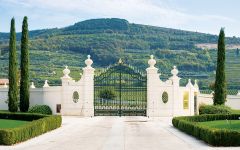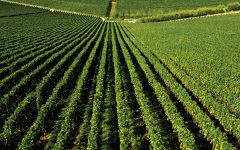Dal Forno Romano Passito Vigna Sere (375ML half-bottle) 2004
-
Robert
Parker



Product Details
Your Rating
Somm Note
Winemaker Notes
Produced in very limited amounts and on very rare occasions, it constitutes the emblem of the land from where it hails. Recioto, the symbol of Verona, is the wine from which originates this concentration of fruit.
Vigna Seré possesses immense opulence and density, with preeminent hints of plum, black cherry, raspberry, chocolate and coffee. A good level of sharpness supports the refined tannins that, with their sweetness and elegance, gift the drinker moments of intense emotions. Persistence. Nuances of truffle, tobacco and new leather wrap around the finish. Unique in its class, the essence of this wine epitomizes all the passion and experience that we have developed over the years in our profound devotion towards our work.
Professional Ratings
-
Robert Parker's Wine Advocate
The 2004 Passito Rosso Vino Dolce Vigna Seré (500-mililiter) is a masterpiece that is impossible to repeat. In fact, the wine has not been produced since 2004. Even if a vintage as good as this did come along, we'd need to wait another 13 years before we could enjoy this level of maturity and evolution. Formally a Recioto della Valpolicella, this sweet red wine is made with air-dried fruit as local tradition dictates. Luckily no botrytis set in that year, because that would have eroded the wine's deep and luscious color saturation. The bouquet delivers a generous flow of dark spice, bitter chocolate, espresso, raisin, plum, barbecue spice and teriyaki smoke. The concentration and layering of the wine are both rare and distinctive. The mouthfeel sees sweet flavors with a syrupy mouthfeel. The finish offers hints of caramelized brown sugar and savory hickory. The aging window is impossible to predict, but the wine is surely built to last. I can think of no other wine that comes close to matching this unique style.
Other Vintages
2003-
Wine
Spectator -
Robert
Parker







The Dal Forno family has been making wine since 1983. Located in Val D’Illasi, the estate consists of 65 acres of vines planted to traditional indigenous varieties of Corvina, Corvinone, Rodinella, Oseleta, and Croatina. The estate vineyards and farm are located where the slopes begin to rise toward the mountains and sit 1,000 feet above sea level. The loose, alluvial soils, meticulous pruning and scrupulous viticultural techniques ensure remarkable-quality grapes. The Dal Fornos use traditional methods to grow the finest fruit, and then employ modern techniques to produce the best wines – classic in expression and modern in purity.

Apart from the classics, we find many regional gems of different styles.
Late harvest wines are probably the easiest to understand. Grapes are picked so late that the sugars build up and residual sugar remains after the fermentation process. Ice wine, a style founded in Germany and there referred to as eiswein, is an extreme late harvest wine, produced from grapes frozen on the vine, and pressed while still frozen, resulting in a higher concentration of sugar. It is becoming a specialty of Canada as well, where it takes on the English name of ice wine.
Vin Santo, literally “holy wine,” is a Tuscan sweet wine made from drying the local white grapes Trebbiano Toscano and Malvasia in the winery and not pressing until somewhere between November and March.
Rutherglen is an historic wine region in northeast Victoria, Australia, famous for its fortified Topaque and Muscat with complex tawny characteristics.

Producing every style of wine and with great success, the Veneto is one of the most multi-faceted wine regions of Italy.
Veneto's appellation called Valpolicella (meaning “valley of cellars” in Italian) is a series of north to south valleys and is the source of the region’s best red wine with the same name. Valpolicella—the wine—is juicy, spicy, tart and packed full of red cherry flavors. Corvina makes up the backbone of the blend with Rondinella, Molinara, Croatina and others playing supporting roles. Amarone, a dry red, and Recioto, a sweet wine, follow the same blending patterns but are made from grapes left to dry for a few months before pressing. The drying process results in intense, full-bodied, heady and often, quite cerebral wines.
Soave, based on the indigenous Garganega grape, is the famous white here—made ultra popular in the 1970s at a time when quantity was more important than quality. Today one can find great values on whites from Soave, making it a perfect choice as an everyday sipper! But the more recent local, increased focus on low yields and high quality winemaking in the original Soave zone, now called Soave Classico, gives the real gems of the area. A fine Soave Classico will exhibit a round palate full of flavors such as ripe pear, yellow peach, melon or orange zest and have smoky and floral aromas and a sapid, fresh, mineral-driven finish.
Much of Italy’s Pinot grigio hails from the Veneto, where the crisp and refreshing style is easy to maintain; the ultra-popular sparkling wine, Prosecco, comes from here as well.
